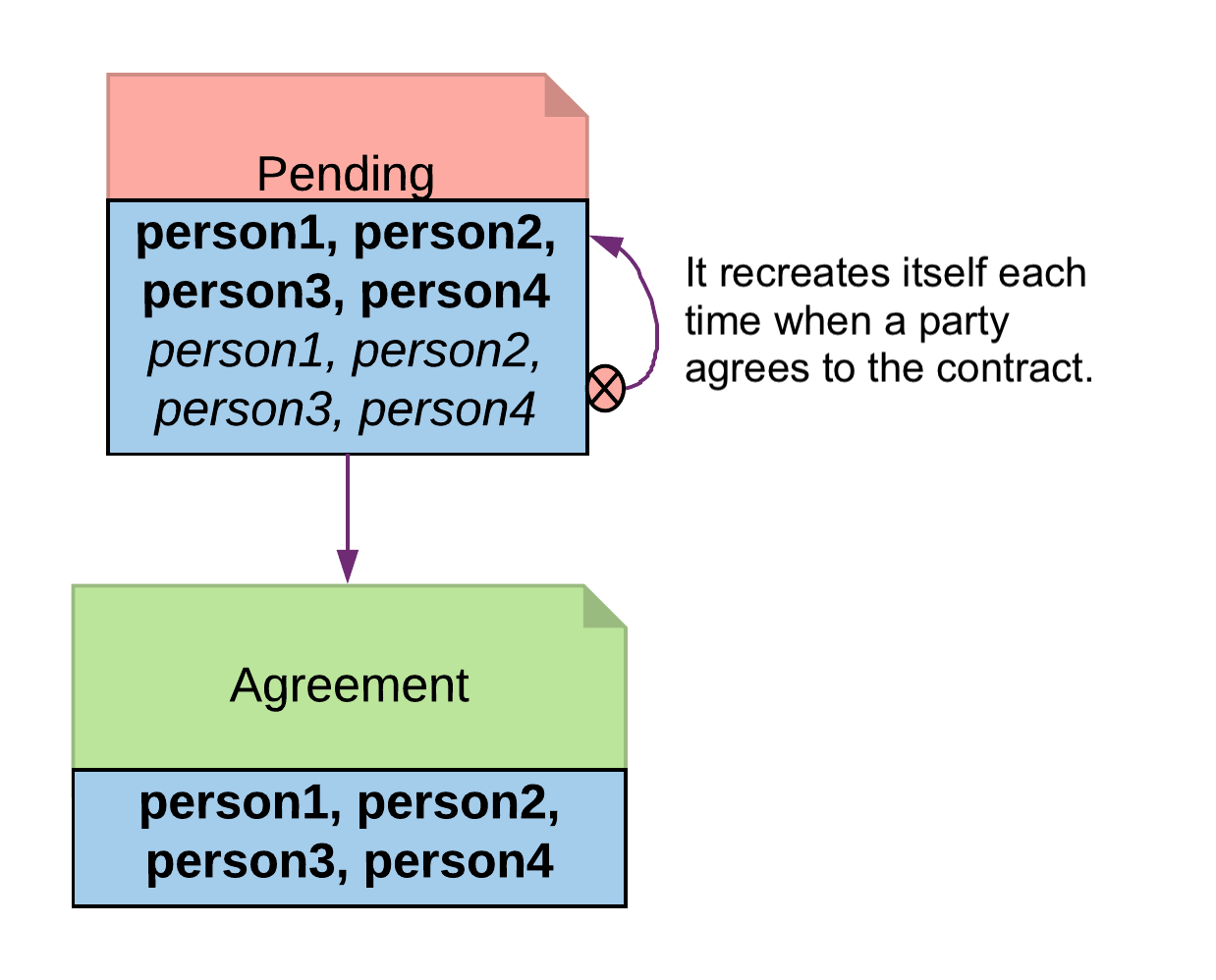Multiple party agreement¶
The Multiple Party Agreement pattern uses a Pending contract as a wrapper for the Agreement contract. Any one of the signatory parties can kick off the workflow by creating a Pending contract on the ledger, filling in themselves in all the signatory fields. The Agreement contract is not created on the ledger until all parties have agreed to the Pending contract, and replaced the initiator’s signature with their own.
Motivation¶
The Initiate and Accept shows how to create bilateral agreements in DAML. However, a project or a workflow often requires more than two parties to reach a consensus and put their signatures on a multi-party contract. For example, in a large construction project, there are at least three major stakeholders: Owner, Architect and Builder. All three parties need to establish agreement on key responsibilities and project success criteria before starting the construction.
If such an agreement were modeled as three separate bilateral agreements, no party could be sure if there are conflicts between their two contracts and the third contract between their partners. If the Initiate and Accept were used to collect three signatures on a multi-party agreement, unnecessary restrictions would be put on the order of consensus and a number of additional contract templates would be needed as the intermediate steps. Both solution are suboptimal.
Following the Multiple Party Agreement pattern, it is easy to write an agreement contract with multiple signatories and have each party accept explicitly.
Implementation¶
- Agreement contract
The Agreement contract represents the final agreement among a group of stakeholders. Its content can vary per business case, but in this pattern, it always has multiple signatories.
template Agreement with signatories: [Party] where signatory signatories ensure unique signatories -- The rest of the template to be agreed to would follow here
- Pending contract
The Pending contract needs to contain the contents of the proposed Agreement contract, as a parameter. This is so that parties know what they are agreeing to, and also so that when all parties have signed, the Agreement contract can be created.
The Pending contract has a list of parties who have signed it, and a list of parties who have yet to sign it. If you add these lists together, it has to be the same set of parties as the
signatoriesof the Agreement contract.All of the
toSignparties have the choice toSign. This choice checks that the party is indeed a member oftoSign, then creates a new instance of the Pending contract where they have been moved to thesignedlist.template Pending with finalContract: Agreement alreadySigned: [Party] where signatory alreadySigned observer finalContract.signatories ensure -- Can't have duplicate signatories unique alreadySigned -- The parties who need to sign is the finalContract.signatories with alreadySigned filtered out let toSign = filter (`notElem` alreadySigned) finalContract.signatories choice Sign : ContractId Pending with signer : Party controller signer do -- Check the controller is in the toSign list, and if they are, sign the Pending contract assert (signer `elem` toSign) create this with alreadySigned = signer :: alreadySigned
Once all of the parties have signed, any of them can create the final Agreement contract using the
Finalizechoice. This checks that all of the signatories for the Agreement have signed the Pending contract.choice Finalize : ContractId Agreement with signer : Party controller signer do -- Check that all the required signatories have signed Pending assert (sort alreadySigned == sort finalContract.signatories) create finalContract
- Collecting the signatures in practice
Since the final Pending contract has multiple signatories, it cannot be created in that state by any one stakeholder.
However, a party can create a pending contract, with all of the other parties in the
toSignlist.parties@[person1, person2, person3, person4] <- makePartiesFrom ["Alice", "Bob", "Clare", "Dave"] let finalContract = Agreement with signatories = parties -- Parties cannot create a contract already signed by someone else initialFailTest <- person1 `submitMustFail` do create Pending with finalContract; alreadySigned = [person1, person2] -- Any party can create a Pending contract provided they list themselves as the only signatory pending <- person1 `submit` do create Pending with finalContract; alreadySigned = [person1]
Once the Pending contract is created, the other parties can sign it. For simplicity, the example code only has choices to express consensus (but you might want to add choices to Accept, Reject, or Negotiate).
-- Each signatory of the finalContract can Sign the Pending contract pending <- person2 `submit` do exercise pending Sign with signer = person2 pending <- person3 `submit` do exercise pending Sign with signer = person3 pending <- person4 `submit` do exercise pending Sign with signer = person4 -- A party can't sign the Pending contract twice pendingFailTest <- person3 `submitMustFail` do exercise pending Sign with signer = person3 -- A party can't sign on behalf of someone else pendingFailTest <- person3 `submitMustFail` do exercise pending Sign with signer = person4
Once all of the parties have signed the Pending contract, any of them can then exercise the
Finalizechoice. This creates the Agreement contract on the ledger.person1 `submit` do exercise pending Finalize with signer = person1

Multiple Party Agreement Diagram

